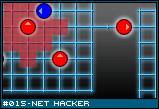|
Mechanic #015 - Net Hacker |

Category: Hacker | Posted: 05/23/07
A game in which you design units by loading programs onto grid. Combat involves attacking these programs from the outside in. |
![[hacker1.png]](set01/img/entry015-hacker1.png)
The above illustration is terrible, but was included in the portfolio write up of this concept, so I figured, what the heck. That's my Tron-style tactics game. Imagine it looks a lot cooler than that and that someone put more than ten minutes of work into it. All the other illustrations will be new to this article though (because if you think this sucks, you should've seen the stuff I'm not recycling!)
![[hacker2.png]](set01/img/entry015-hacker2.png)
The twist to this game is that you customize each individual unit by placing Tetris-shaped programs on a grid. Each program will have some sort of ability or stat-boost available to it. The larger and more oddly-shaped a program, the more powerful it is. For example, a simple 1x1 brick may simply increase attack power slightly, while a 2x1 brick increases attack power even more (perhaps more so than two 1x1 bricks, since it would be more difficult to slot it). Programs can be rotated and placed in any available spot.
Before I'm accused of ripping off Children of Mana, this idea predates that game by many years, and there is a more unique aspect to this idea than simple customization. This idea even predates Mega Man Battle Network 3. Now that the defensive part is out of the way, let's move on to what makes the idea really nifty...
![[hacker3.png]](set01/img/entry015-hacker3.png)
When one unit attacks another, a sort of wave of damage is thrown against the target's grid, depending on which direction the target is attacked from. So if the target is attacked from the back, the damage wave would approach from the bottom. In this example, the target has been attacked on its right side.
The wave itself is a distributed amount of damage, focused on a single row or column, getting weaker as it spreads out. So the center row of this attack wave will be the strongest, while the two rows above and below it will do less damage to their respective rows. The row the wave is centered on is randomly chosen (though no doubt possible to manipulate through equipped programs).
Let's say that each normal blue cell has two hitpoints, light blue = one point each, while dark blue = three hitpoints each. The red block in the center has five hitpoints per cell. The wave does a total of 13 damage (5 in the center, and 4 each for the other two rows). The damage travels outside in, each block soaking up as much damage as possible before being destroyed. Thus, the damage done to the unit's program grid is:
![[hacker4.png]](set01/img/entry015-hacker4.png)
A program continues to function as long as one of its cells is still functional. Here, the dark blue program has lost its lowest square, but retains three others. Thus, it sill works. However, the light blue L-shaped program is complete destroyed, and removed from the grid completed. Damaged cells may be repaired, but a removed program is permanently gone.
![[hacker5.png]](set01/img/entry015-hacker5.png)
So, attacking a unit does damage not just to some arbitrary hitpoints, but has the potential to damage or even destroy skills and abilities. A damaged unit will be less effective than a pristine one. The red square in the middle (which doesn't have to be a 2x2 square, nor does it have to be in the middle) represents the brain of the unit. If the brain is completely destroyed, the unit dies.
|